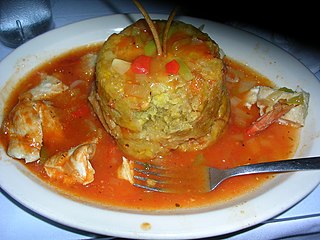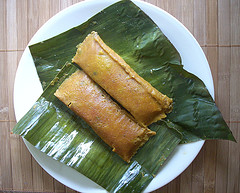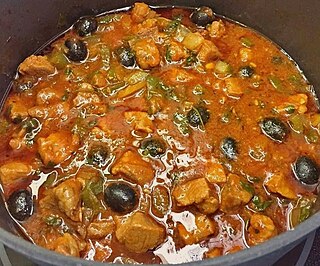  Alcapurria | |
| Course | Appetizer |
|---|---|
| Place of origin | Puerto Rico |
| Serving temperature | Hot |
| Main ingredients | Green banana, yautía, achiote and meat |
| Other information | Popular throughout: Puerto Rico |
Alcapurria is a popular fritter dish from Puerto Rico. [1] [2]
  Alcapurria | |
| Course | Appetizer |
|---|---|
| Place of origin | Puerto Rico |
| Serving temperature | Hot |
| Main ingredients | Green banana, yautía, achiote and meat |
| Other information | Popular throughout: Puerto Rico |
Alcapurria is a popular fritter dish from Puerto Rico. [1] [2]
It may have influence from Middle Eastern kibbeh due to the immigration of Levantine Arabs as well as Armenians throughout Latin America. [3]
The dough surrounding the filling, the masa, is made primarily of green banana and grated yautía with optional addition of squash. Green banana can be replaced with breadfruit, cassava, taro, green or yellow plantains or other arrowroots. Alcapurrias are generally seasoned with lard, annatto, garlic and salt. The annatto gives it signature yellow/orange color. [4] Annatto seeds are simmered in lard to release most of its color and flavor. Seeds are discarded and the tinted lard is then poured over the masa.
The masa is refrigerated for several hours to achieve a solid consistency. Diced potatoes cooked with picadillo or corned beef are the most typical fillings; others include longaniza, blood sausage, braised meat, cheese, seafood and vegetables. [5] They can be deep-fried in lard or oil, or baked (alcapurrias horneadas). [6] When cooked, the fritter is "hot and brittle". [7] Alcapurrias are served at kiosks and at fine restaurants, as well. [8]

Cooking bananas are a group of starchy banana cultivars in the genus Musa whose fruits are generally used in cooking. They are not eaten raw and generally starchy. Many cooking bananas are referred to as plantains or 'green bananas'. In botanical usage, the term "plantain" is used only for true plantains, while other starchy cultivars used for cooking are called "cooking bananas". True plantains are cooking cultivars belonging to the AAB group, while cooking bananas are any cooking cultivar belonging to the AAB, AAA, ABB, or BBB groups. The currently accepted scientific name for all such cultivars in these groups is Musa × paradisiaca. Fe'i bananas from the Pacific Islands are often eaten roasted or boiled, and are thus informally referred to as "mountain plantains", but they do not belong to any of the species from which all modern banana cultivars are descended.

A tamale, in Spanish tamal, is a traditional Mesoamerican dish made of masa, a dough made from nixtamalized corn, which is steamed in a corn husk or banana leaves. The wrapping can either be discarded prior to eating or used as a plate. Tamales can be filled with meats, cheeses, fruits, vegetables, herbs, chilies, or any preparation according to taste, and both the filling and the cooking liquid may be seasoned.

Puerto Rican cuisine consists of the cooking style and traditional dishes original to Puerto Rico. It has been primarily a fusion influenced by the ancestors of the Puerto Rican people: the indigenous Taínos, Spanish Criollos and sub-Saharan African slaves. As a territory of the United States, the culinary scene of Puerto Rico has also been moderately influenced by American cuisine.

Annatto is an orange-red condiment and food coloring derived from the seeds of the achiote tree, native to tropical parts of the Americas. It is often used to impart a yellow to red-orange color to foods, but sometimes also for its flavor and aroma. Its scent is described as "slightly peppery with a hint of nutmeg" and flavor as "slightly nutty, sweet and peppery".

Hallaca is a traditional Venezuelan dish. Its origin is indigenous, but raisins, capers, olives, and sometimes bits of bacon were added in the 16th Century and after by settlers from the Iberian peninsula. Hallaca consists of corn dough stuffed with a stew of beef, pork, or chicken and other ingredients such as raisins, capers, and olives, fresh onion rings, red and green bell pepper slices. There are vegetarian hallacas, made with black beans or tofu. Hallacas are folded in plantain leaves, tied with strings, and boiled. The dish is traditionally served during the Christmas season and has several regional variants. It has been described as a national dish of Venezuela. Some speculate it originated from the Orinoquia. Characteristic of the hallaca is the delicate corn dough made with consommé or broth, and lard colored with annatto. Hallacas are also commonly eaten in eastern Cuba, Trinidad where it is called pastelle, and parts of Colombia, Ecuador, Aruba, and Curaçao.

A nacatamal is a traditional Nicaraguan dish similar to the tamal and to the hallaca. Nacatamales originated from the Nicarao tribes who inhabited western Nicaragua, its name originates from the Nawat language and translates to 'meat tamale'. During pre-columbian times, the Nicarao were using hunted meats like deer and turkey with ingredients such as tomatoes, achiote and herbs to season and increase the nacatamal's flavor before being wrapped in corn husks and steamed. After Spanish conquest, nacatamales were made with introduced meats like pork. They also evolved to include flavorful ingredients like onions and banana leaves replaced corn husks. The nacatamal is perhaps the most produced within traditional Nicaraguan cuisine and is typically eaten on the weekend, for dinner, or for breakfast; it is usually eaten together with white bread and a caffeinated drink like black coffee, Coca-Cola or Pepsi. It is common to enjoy nacatamales (plural) during special occasions and to invite extended family and neighbors to partake.

Mofongo is a dish from Puerto Rico with plantains as its main ingredient. Plantains are picked green, cut into pieces and typically fried but can be boiled or roasted, then mashed with salt, garlic, broth, and olive oil in a wooden pilón. The goal is to produce a tight ball of mashed plantains that will absorb the attending condiments and have either pork cracklings (chicharrón) or bits of bacon inside. It is traditionally served with fried meat and chicken broth soup. Particular flavors result from variations that include vegetables, chicken, shrimp, beef, or octopus packed inside or around the plantain orb.

Sofrito, sofregit, soffritto, or refogado, is a basic preparation in Mediterranean, Latin American, Spanish, Italian and Portuguese cooking. It typically consists of aromatic ingredients cut into small pieces and sautéed or braised in cooking oil for a long period of time over a low heat.

A buñuelo (Spanish:[buˈɲwelo], alternatively called boñuelo, bimuelo, birmuelo, bermuelo, bumuelo, burmuelo, or bonuelo, is a fried dough fritter found in Spain, Latin America, and other regions with a historical connection to Spaniards, including Southwest Europe, the Balkans, Anatolia, and other parts of Asia and North Africa. Buñuelos are traditionally prepared at Christmas. It will usually have a filling or a topping. In Mexican cuisine, it is often served with a syrup made with piloncillo.
Green bananas are unripe bananas used in cuisines worldwide. They have a firmer texture and a starchy, mildly astringent taste compared to their ripe counterparts.

Picadillo is a traditional dish in many Latin American countries including Mexico and Cuba, as well as the Philippines. It is made with ground meat, tomatoes, and also raisins, olives, and other ingredients that vary by region. The name comes from the Spanish word picar, meaning "to mince".

Cuchifritos or cochifritos refers to various fried foods prepared principally of pork in Spanish and Puerto Rican cuisine. In Spain, cuchifritos are a typical dish from Segovia in Castile. The dish consists of pork meat fried in olive oil and garlic and served hot. In Puerto Rico they include a variety of dishes including morcilla, papas rellenas, and chicharron, and other parts of the pig prepared in different ways. Some cuchifritos dishes are prepared using plantain as a primary ingredient. Cuchifritos vendors also typically serve juices and drinks such as passionfruit, pineapple, and coconut juice, as well as ajonjolí, a drink made from sesame seeds.

Pasteles, also pastelles in the English-speaking Caribbean, are a traditional dish in several Latin American and Caribbean countries. In Puerto Rico, the Dominican Republic, Venezuela, Panama, Trinidad and Tobago, and the Caribbean coast of Colombia, the dish looks like a tamal. In Hawaii, they are called pateles in a phonetic rendering of the Puerto Rican pronunciation of pasteles, as discussed below.

Dominican cuisine is made up of Spanish, indigenous Taíno, Middle Eastern, and African influences. The most recent influences in Dominican cuisine are from the British West Indies and China.

Fried plantain is a dish cooked wherever plantains grow, from West Africa to East Africa as well as Central America, the tropical region of northern South America and the Caribbean countries like Haiti to Cuba and in many parts of Southeast Asia and Oceania, where fried snacks are widely popular. In Indonesia it is called gorengan. It is called dodo in Yoruba in South West Nigeria, otherwise known as simply fried plantain in other parts of Nigeria. Kelewele is a fried spicy plantain or can be fried as a side dish for Red Red and fish stew in Ghana.
Pastel is the Spanish and Portuguese word for pastry, a sugary food, and is the name given to different typical dishes of various countries where those languages are spoken. In Mexico, pastel typically means cake, as with Pastel de tres leches. However, in different Latin American countries pastel can refer to very different sugary dishes, and even to non-sugary ones as well. In some places, like Brazil, a pastel can refer to both a sugary and non-sugary food, depending on the filling used.

Most traditional foods in Guatemalan cuisine are based on Mexican and Maya cuisine, with Spanish influence, and prominently feature corn, chilies and beans as key ingredients. Guatemala is famously home to the Hass avocado.

Arroz con gandules is a combination of rice, pigeon peas, and pork, cooked in the same pot with sofrito. This is Puerto Rico's national dish along with roasted pork.

Pastele stew is a Hawaii inspired pork stew of Puerto Rican origin. It is an adaptation of the dish pasteles introduced by the Puertorriqueños who came to work on the sugar plantations in the early 1900s. Pastele making is often a laborious task reserved for special occasions and holidays such as Christmas. Pastele stew was developed as a simplified everyday version.